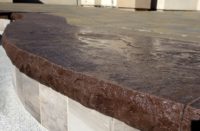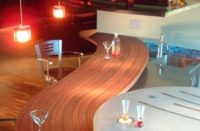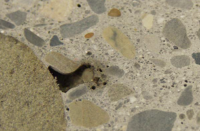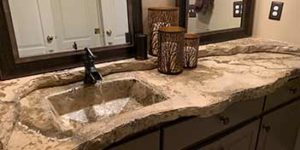It’s pretty easy to create a concrete countertop that looks like a garage floor. But branching out from flatwork to countertops means embracing completely different ideas on aesthetics and performance, not to mention learning different skills. Mike Moncrieff has made the leap.
Like many entrepreneurs who break into decorative concrete, Mike Moncrieff was driven to a more creative outlet by the monotony of flatwork.
“I’ve always been a very artistic person, from drawing to painting and graffiti to tattooing and even music,” Moncrieff says. Working for his father Sam’s construction business, Moncrieff Construction, gave him practical, hands-on experience pouring concrete slabs. He became a talented finisher and was supervising the flatwork crews by the age of 23. What the job didn’t give him was a passion.
Bored one day after pouring a small driveway, Moncrieff made molds for a couple of concrete benches. He liked how they came out. Then he tried a coffee table, which he liked even more. Moncrieff started researching decorative concrete and discovered Fu-Tung Cheng’s hugely popular book, “Concrete Countertops.” He was hooked.
Cheng is a pioneer in the craft of concrete countertop design, and Moncrieff had to learn from the master, taking one of his first training classes. After experimenting like a madman, Moncrieff eventually felt comfortable enough to start his own business with his wife Tara and one employee. New Edge Design LLC and its first product line, Monart Concrete Countertops, were launched about four years ago in Lynden, Wash., where Moncrieff creates one-of-a-kind sinks and countertops for upscale private homes and businesses.
It’s pretty easy to create a concrete countertop that looks like a garage floor. But branching out from flatwork to countertops means embracing completely different ideas on aesthetics and performance, not to mention learning different skills. And because concrete countertops are growing in popularity, homeowners are at risk of hiring a contractor who is not well practiced in the techniques needed to create the glasslike texture, subtle colors, precise edges and unusual forms that are in demand today.
Moncrieff has clearly made the leap. He took Cheng’s advanced class about a year ago, and his work has been recognized with six awards at Cheng’s first three annual design competitions.
 |
Monart’s biggest selling point, in fact, is the artistry of Moncrieff’s designs. He likes to work with clients to incorporate their personality into their countertops. For example, a client who traveled extensively asked that coins from around the world be inlaid into the surface. Another asked Moncrieff to use chips of petrified wood she collected as a child. Many people give him rocks gathered from beaches or lakes near their homes. He has even embedded a tiny vial of ashes so a client could remember her cappuccino-loving mother every time she poured a cup of coffee.
One homeowner raves about her countertop on Monart’s Web site, Newcountertops.com: “We were able to showcase several meaningful rocks from back home by embedding them in our new island countertop. Everyone wants to touch and feel it. It has become a real conversation piece and a gathering spot. We’re thrilled with how it turned out.”
Moncrieff has developed his own molds, as well as what he calls “concrete on steroids.” His homemade mix results in a surface that is smooth and stain-resistant. His countertops are precast at his shop. Moncrieff doesn’t pour in place because he has less control over conditions, including the distraction of having other contractors on the scene.
One mold was particularly demanding to build, involving a nine-inch lip on one side and a four-inch lip on the other. Exacting techniques were needed to make perfect edges fit to an existing lower countertop, and Moncrieff had the added pressure of installing for an audience. As Moncrieff fiddled around, waiting for the homeowners and their friends to leave, he realized they were happily anticipating the outcome and weren’t going anywhere. “It came out twice as good as they expected,” he says.
Moncrieff readily acknowledges that concrete sinks and countertops are not for everyone — the fact that it’s a hot new trend in upscale kitchen design isn’t enough. Homeowners have to love the characteristics of concrete and be willing to pay for the labor involved ($80 per square foot and up for standard 1.5-inch-thick countertops). Moncrieff has found that people who want concrete do a lot of research online, and an attractive Web site is a great marketing tool.
However, Moncrieff wants to keep his business small and manageable. “I really want to keep every job in my hands,” he says. “Customers appreciate that.”
Moncrieff has also made fireplace hearths and mantles, wall caps, outdoor kitchens, shower stalls and desks. He’d like to do more designs of islands as the focal point of a new kitchen. That way, he’d be involved in the design on the front end rather than coming in afterward.
While concrete countertops are taking off, Mike and Tara Moncrieff still find lots of people who don’t know much about them, and they’re happy to do the educating. “I’m not really a big people person — I try to stay away from crowds,” Mike says. “But when I talk about concrete, you’d think I loved talking to people”
Tara says many visitors at a recent home show confused her husband’s concrete countertop with granite. When people ask her why they should choose concrete over granite, she has a simple answer: “There’s no other surface out there that can be customized and personalized like concrete can. You’re not just getting a countertop, you’re getting a piece of art.”




































